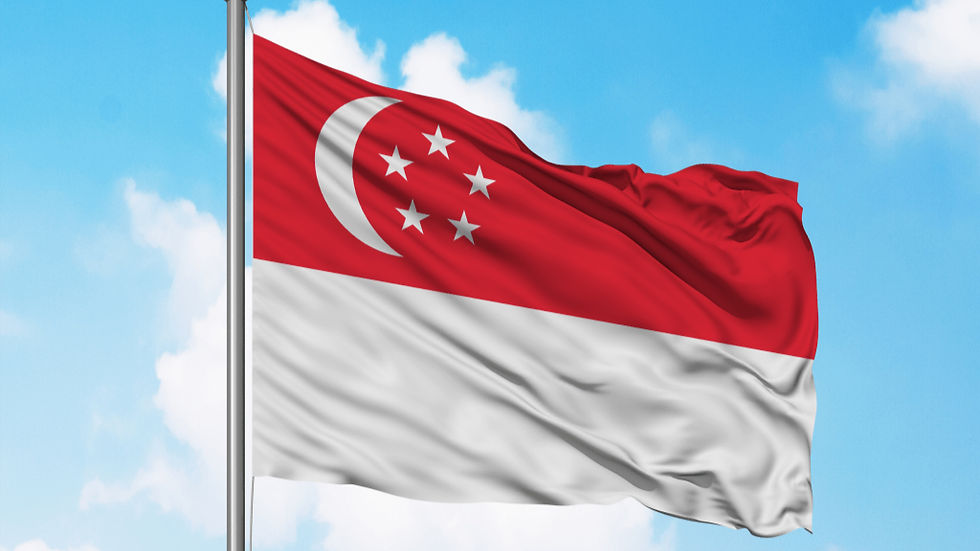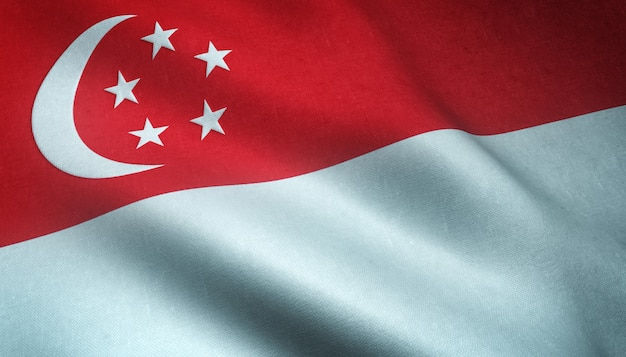Singapore Flag Guide - Meaning, Etiquette and History
- lionheartlanders

- Sep 3, 2025
- 7 min read
The Singapore flag stands as our nation's most cherished symbol, representing everything that unites us as Singaporeans. More than just a piece of fabric, this red and white banner tells the story of our journey from colonial past to modern prosperity, embodying the values and aspirations that define our national identity. For Singaporeans seeking to deepen their connection with their heritage, understanding the rich symbolism, historical significance, and proper etiquette of our national flag offers a meaningful way to rediscover Singapore through guided walks and educational experiences.
History of the Singapore Flag

The story of Singapore's national flag begins with our transformation from British colony to self-governing nation. Prior to 1959, Singapore flew various colonial flags, including the British Blue Ensign with symbols representing the Straits Settlements. The city had been granted a coat of arms featuring a lion in 1911, reflecting the meaning of Singapore as "Lion City," but no distinct flag of its own.
The pivotal moment came when Singapore achieved self-government within the British Empire on June 3, 1959. Then-Deputy Prime Minister Dr Toh Chin Chye was tasked with leading a committee to create a new national flag that would replace the Union Jack, which had flown over the island for nearly 140 years. Dr Toh approached this responsibility with meticulous care, studying flags of United Nations member countries to ensure Singapore's design would be unique.
Initially, Dr Toh was hesitant about using red and white colors, as he explained in a 1989 oral history interview: "White above red is the flag of Poland. Red above white is the flag of Indonesia". However, after careful deliberations by the Legislative Assembly, the red and white design was endorsed on November 18, 1959, alongside the state crest and national anthem.
The flag was officially unveiled on December 3, 1959, at the installation of Singapore's first Malayan-born Yang di-Pertuan Negara (Head of State), Yusof bin Ishak, in the City Hall chambers. The ceremony marked not only the introduction of our national flag but also our emergence as a distinct political entity. Remarkably, the flag's design remained unchanged when Singapore joined Malaysia in 1963 and again when we gained full independence on August 9, 1965.
Meaning Behind the Design of the Singapore Flag

Every element of the Singapore flag carries profound symbolic meaning, carefully chosen to represent our nation's character and aspirations. The flag consists of two equal horizontal sections - red above white - with distinctive white symbols in the upper left canton.
The red stripe symbolizes universal brotherhood and equality of all people, reflecting our commitment to racial harmony and social cohesion. This choice was particularly significant given the communal tensions of the 1950s and 1960s, emphasizing our determination to build a unified multiracial society.
The white stripe represents pervading and everlasting purity and virtue, embodying our nation's moral foundations and integrity. Together, these two colors create a visual representation of the balance between passionate commitment to our ideals and the clarity of purpose that guides our actions.
The crescent moon positioned in the red section represents Singapore as a young nation on the ascendant. Dr Toh Chin Chye specifically chose this symbol to signify our status as an emerging country with unlimited potential for growth and development.
The five white stars arranged in a circle beside the crescent represent Singapore's fundamental ideals: democracy, peace, progress, justice, and equality. These principles form the cornerstone of our national identity and continue to guide our development as a modern society.
Importantly, while crescents and stars on other flags often carry religious connotations, Singapore's symbols are entirely secular. They represent civic values and national aspirations rather than any particular faith, reflecting our commitment to religious harmony and inclusivity.
Proper Etiquette and Guidelines for the Singapore Flag
Understanding proper flag etiquette demonstrates respect for our national symbol and reflects our pride as Singaporeans. The National Symbols Act 2022 and its Regulations, which took effect on August 1, 2023, provide comprehensive guidelines for respectful use of the flag.
Display Requirements
The Singapore flag must always be produced in its true colors (Pantone 032 red and Pantone White) and proper proportions, maintaining a ratio of 2 (width) to 3 (length). When displaying the flag outside buildings, it typically must be flown from a flagpole in front of the building and properly illuminated at night.
However, during the National Day celebrations period from July 1 to September 30 each year, these rules are relaxed. During this time, the flag may be displayed on buildings without requiring a flagpole or night illumination, encouraging all Singaporeans to show their patriotic spirit.
Position of Honor
When displayed with other flags, the Singapore flag must occupy the position of honor - above or to the left of other flags as seen when facing them. The flag should never be positioned below any other flag, emblem, or object, maintaining its status as our supreme national symbol.
The flag should always be displayed upright, with the crescent moon and five stars in the upper left red section near the pole. It must never be flown upside-down except in cases of extreme distress, following international protocols.
Clothing and Attire Guidelines
Recent changes to regulations have made it easier for Singaporeans to show national pride through clothing. The flag or its image can now be used on attire for non-commercial purposes year-round without requiring ministerial approval, provided it's done respectfully.
When placing the flag image on clothing, it should be positioned above the waist. The image should never appear on inappropriate items such as undergarments or in areas intended to be soiled, such as across the front of face masks. For official representation of the nation, the flag should be positioned near the top of the garment.
Items to Avoid
The flag image should never be used on items intended to be discarded, torn, or dirtied. This includes plastic packaging, paper napkins, trash bags, tablecloths, doormats, or car tires. It's also inappropriate to use the flag on items associated with funerals or as false endorsement of products and services.
Singapore flags displayed prominently along a public walkway fluttering in the breeze in an urban Singapore setting
Proper Care and Disposal
Treating the flag with dignity extends to its maintenance and disposal. Flags should be cleaned when dirty and replaced when faded or torn. The flag should never be hung out to dry with other laundry, as this may be considered disrespectful.
When a flag becomes worn out or damaged, it should be properly disposed of by packing it into a sealed black trash bag rather than leaving it visible in dustbins. This respectful disposal honors the symbol even at the end of its useful life.
Modern Usage and Digital Applications
With technological advances, the regulations now cover digital and other types of reproduction of the flag. Creative illustrations can incorporate flag elements, but designs should not deviate significantly from the original. This means maintaining the correct colors and not depicting torn, broken, or tattered versions of the flag.
Images or graphics should be placed below or beside the flag image rather than covering it, particularly avoiding obstruction of key elements like the crescent and five stars. These guidelines ensure that even modern adaptations maintain the dignity and recognizability of our national symbol.
Singapore Flag in National Celebrations

The Singapore flag takes center stage during our most important national celebrations, serving as a focal point for expressing collective identity and pride. During National Day celebrations, the flag becomes ubiquitous across the island - from government buildings to residential estates, shopping centers to schools.
The relaxed regulations during the National Day period from July to September reflect our understanding that patriotism flourishes when citizens can freely express their love for country. This three-month celebration period allows families and communities to display the flag in ways that strengthen social bonds and reinforce shared identity.
The flag-raising ceremony at schools, military installations, and government buildings follows specific protocols that add solemnity to the act. The flag should be raised briskly and lowered ceremoniously, never touching the ground during the process. These ceremonies often include the singing of the national anthem and recitation of the national pledge, creating powerful moments of collective unity.
Educational Value and Cultural Significance
For educators, parents, and community leaders, the Singapore flag serves as an invaluable tool for teaching national values and history. The flag's symbols provide concrete talking points for discussing abstract concepts like democracy, justice, and equality with young Singaporeans.
Understanding flag etiquette also teaches respect for symbols and institutions, fostering civic responsibility and national consciousness. These lessons become particularly meaningful when experienced through guided educational walks and heritage programs that connect flag symbolism to real places and stories in Singapore.
The flag's evolution from colonial symbols to our distinctive national emblem mirrors Singapore's own transformation from dependent territory to sovereign nation. This parallel helps Singaporeans of all ages appreciate both how far we've come and the values that will guide our future development.
Learning about the history and meaning of the Singapore Flag through official National Heritage Board resources, combined with understanding proper dos and don'ts from the National Library Board, empowers every Singaporean to be a proper custodian of our national symbols.
The Singapore flag represents more than national identity - it embodies our collective aspirations and shared commitment to building a society based on mutual respect, equality, and progress. By understanding its history, respecting its symbolism, and following proper etiquette, we honor not just a symbol but the values and sacrifices that created modern Singapore.
Whether displayed during major celebrations or incorporated thoughtfully into daily life, our national flag remains a powerful reminder of who we are as Singaporeans and what we can achieve together. Every time we see it flying proudly, we're reminded of our responsibility to uphold the principles it represents and to continue building the nation it symbolizes.
For those inspired to learn more about the Singapore flag and its role in shaping our national identity, consider joining heritage walks and educational programs that bring these stories to life through immersive experiences in the places where our history unfolded.




Comments